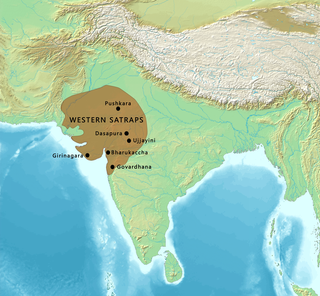
The Western Satraps, or Western Kshatrapas were Indo-Scythian (Saka) rulers of the western and central part of India, between 35 to 415 CE. The Western Satraps were contemporaneous with the Kushans who ruled the northern part of the Indian subcontinent, and were possibly vassals of the Kushans. They were also contemporaneous with the Satavahana (Andhra) who ruled in Central India. They are called "Western Satraps" in modern historiography in order to differentiate them from the "Northern Satraps", who ruled in Punjab and Mathura until the 2nd century CE.

The Vakataka dynasty was an ancient Indian dynasty that originated from the Deccan in the mid-3rd century CE. Their state is believed to have extended from the southern edges of Malwa and Gujarat in the north to the Tungabhadra River in the south as well as from the Arabian Sea in the west to the edges of Chhattisgarh in the east. They were the most important successors of the Satavahanas in the Deccan and contemporaneous with the Guptas in northern India.
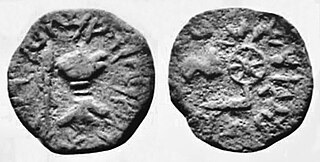
Bhumaka was a Western Kshatrapa ruler of the early 2nd century CE. He was the father of the great ruler Nahapana, according to one of the latter's coins. He was preceded by Abhiraka (Aubhirakes), of whom a few coins are known.

Chashtana was a ruler of the Saka Western Satraps in northwestern India during 78-130 CE, when he was the satrap of Ujjain.

Rudrasena I was a Saka ruler of the Western Satrap dynasty in the area of Malwa in ancient India. During his reign, the Saka ksatrapas remained strong after a period of instability during the reign of Rudrasimha I.

The Traikutakas were a dynasty of Indian kings who ruled between 388 and 456. The name "Traikutakas" seems to be derived from the words for a three-peaked mountain ("Tri-kuta"). The Traikutakas are mentioned in Kalidasa's Raghuvamsa, in which they are located in the area of northern Konkan. The dominions of the Traikutakas further included Aparanta and northern Maharashtra.

Rudrasimha III was the last ruler of the Western Satraps in India, in the 4th century AD. Rudrasimha III succeeded Rudrasena IV as the leader of the Indo-Scythians in India. Both were the sons of the Saka ruler Satyasimha, making them at least half-brothers, if not first-degree relatives.
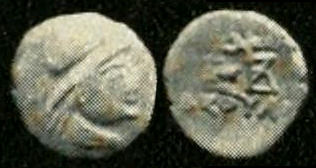
Liaka Kusulaka was an Indo-Scythian satrap of the area of Chukhsa in the northwestern South Asia during the 1st century BCE.
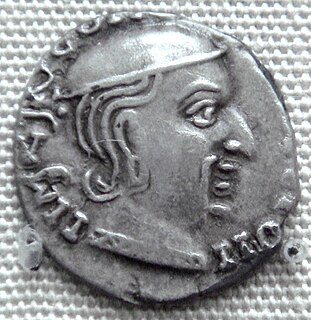
Jivadaman was a Saka ruler of the Western Kshatrapas in northwestern India from during the 2nd century CE. He was the son of Damajadasri I (170–175), and the brother of Satyadaman.

Harishena was the last known ruler of the Vatsagulma branch of the Vakataka dynasty. He succeeded his father Devasena. Harishena was a great patron of Buddhist architecture, art and culture, with the World Heritage monument of Ajanta being his greatest legacy. He is also credited with many conquests. The end of Harishena's reign and the ultimate fate of the Vatsagulma branch is shrouded in mystery, as it seems the Vakataka dynasty came to an end not long after the death of Harishena.
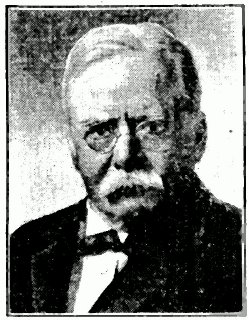
Edward James Rapson FBA was a British numismatist, philologist and professor of Sanskrit at the University of Cambridge. He was a fellow of St. John's College. Rapson died following a sudden collapse at dinner at St. John's.

Prithivishena I was a ruler of the Nandivardhana-Pravarapura branch of the Vakataka dynasty. He was the son and successor of Rudrasena I, the founder of the branch.

Vindhyasena, also known as Vindhyashakti II, was a ruler of the Vatsagulma branch of the Vakataka dynasty. He was the son and successor of Sarvasena I.

Kharapallana was an Indo-Scythian Northern Satrap who ruled around c. 130 CE.

Rudrasimha II (304–348) was a ruler of the Western Satraps He declared on his coins to be the son of a Lord (Svami) named Jivadaman.

Yasodhaman II (317–332) was a son and probably sub-king of king Rudrasimha II of the Western Satraps He declared on his coins to be the son of Rudrasimha II.

Damasena was a Western Kshatrapa ruler, who reigned from 223 to 232 CE. From the reign of Rudrasimha I, the date of minting of each coin, reckoned in the Saka era, is usually written on the obverse behind the king's head in Brahmi numerals, allowing for the quite precise dating of the rule of each king. This is a rather uncommon case in Indian numismatics. Some, such as the numismatist R.C Senior considered that these dates might correspond to the much earlier Azes era instead.

Satyadaman was a ruler of the Western Satraps. He was the son of king Damajadasri I and brother of Jivadaman, who had been king, but sometime before him.
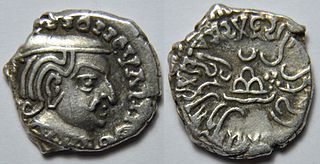
Damajadasri III was a ruler of the Western Satraps. His reign lasted possibly from c. 251 AD to 256 AD.

Prithivishena II was a ruler of the Nandivardhana-Pravarapura branch of the Vakataka dynasty. He succeeded his father Narendrasena as Maharaja. Prithivishena II is the last known king of the main Vakataka line, which is no longer attested after his reign.


















